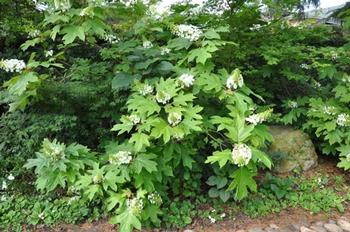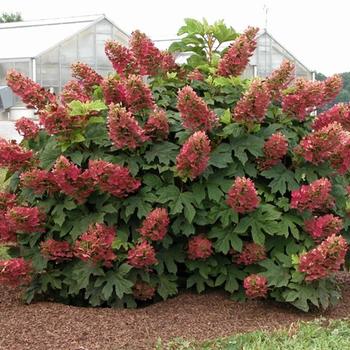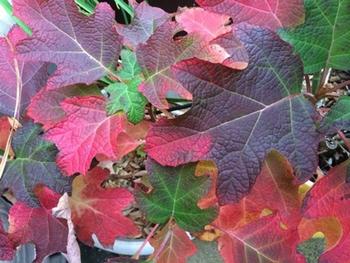Oakleaf hydrangea
-
Hydrangea quercifolia
 ‘Pee Wee’ grows 4 feet tall and 3 feet wide, just right for most backyard settings. Photo: PlantMaster
‘Pee Wee’ grows 4 feet tall and 3 feet wide, just right for most backyard settings. Photo: PlantMasterOakleaf hydrangeas offer year-round interest to the garden. In spring, the young leaves unfurl bright green and fuzzy. Long, cone-shaped, mostly white flower buds appear, turning purple as they mature in the late spring and summer, before they eventually morph to pinkish-brown tones. In fall the leaves gradually turn purple, burgundy, or red and are lovely in the landscape and in floral arrangements. Once the leaves fall in early winter, interesting reddish-brown exfoliating bark is revealed, reminiscent of manzanita.
Beautiful, low-water, disease resistant
These beautiful deciduous shrubs are native to the southeastern United States. Unlike the well-known moisture-loving mophead and lacecap hydrangeas, oakleaves thrive in our Mediterranean climate. They can grow in full sun or full shade, although partial shade is ideal. Rather slow growers, these plants do best in rich, well-drained soil that’s amended with compost and a serving of organic fertilizer once a year. Other than that, they require very little care or water. With no known pest or disease problems, oakleaves are a desirable garden addition. All parts of the plant are considered toxic, although there have been no recent reports of animal poisoning, and deer are very attracted to the young leaves and buds. Oakleaf hydrangeas like this ‘Ruby Slippers’ cultivar offer year-round beauty with minimal care. Photo: PlantMaster
Oakleaf hydrangeas like this ‘Ruby Slippers’ cultivar offer year-round beauty with minimal care. Photo: PlantMasterMany sizes available
There are numerous cultivars available. Most range from 6 to 7 feet tall with a similar girth, although some specimens may reach 15 feet tall. Carefully review the size noted on the nursery nametag. There are also miniature varieties with engaging names like Pee-Wee and Munchkin to consider.
 The oakleaf hydrangea name refers to its leaf shape, which is deeply lobed, much like the northern red oak. Photo: PlantMaster
The oakleaf hydrangea name refers to its leaf shape, which is deeply lobed, much like the northern red oak. Photo: PlantMaster
Prune in mid-summerBlooms form on old wood, so mid-summer pruning is recommended. Pruning later could limit blooms the following spring. Just let it grow and enjoy the abundant blooms next spring.
Oakleaf hydrangeas can be an excellent addition to your garden, planted individually as a specimen plant or as a landscape border. The changing, year-round appeal may be just what you’re looking for!



